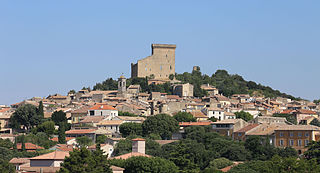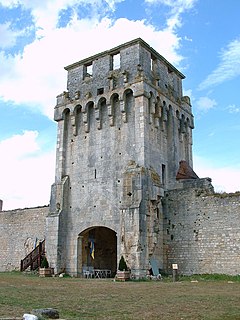
Châteauneuf-du-Pape is a commune in the Vaucluse department in the Provence-Alpes-Côte d'Azur region in Southeastern France. The village lies about 3 kilometres (1.9 mi) to the east of the Rhône and 12 kilometres (7.5 mi) north of the town of Avignon. In the 2012 census the commune had a population of 2,179.

Les Clayes-sous-Bois is a commune in the Yvelines department in the Île-de-France region in north-central France. It is located in the western suburbs of Paris 26.7 km (16.6 mi) from the center. The Clayes-sous-Bois inhabitants are called "Clétiens".

The Château de Sully-sur-Loire is a castle, converted to a palatial seigneurial residence, situated in the commune of Sully-sur-Loire, Loiret, France.

The Château de la Madeleine is a castle located in the town of Chevreuse, in the French département of Yvelines. In a good state of preservation, it was built on the top of a hill and dominates the town.

Tourbillon Castle is a castle in Sion in the canton of Valais in Switzerland. It is situated on a hill and faces the Basilique de Valère, located on the opposite hill.

Ambleville is a commune in the Charente department in the Nouvelle-Aquitaine region of southwestern France.

Dalečín is a village and municipality (obec) in Žďár nad Sázavou District in the Vysočina Region of the Czech Republic. Dalečín lies approximately 23 kilometres (14 mi) east of Žďár nad Sázavou, 53 km (33 mi) north-east of Jihlava, and 142 km (88 mi) south-east of Prague. The municipality consist of the Dalečín, Hluboké and Veselí. Chudobín had been part of the municipality since 1955 until its flooding by Vír Dam.

Heisdorf Castle located in the village of Heisdorf in central Luxembourg was built by Baron Lippmann in the late 19th century. Surrounded by a large park, it was designed by the Belgian architect Charles Thirion. In 1916, the Sisters of the Christian Doctrine acquired the property as a convalescent home for their community. In 1982, it was opened as an old people's home under the name of Maison de retraite Marie-Consolatrice. In 2007, a new wing was added to the building by the architecture firm Hermann, Valentiny and Partners providing improved facilities for its senior citizens.

Donneloye Castle is a manor house in the municipality of Donneloye of the Canton of Vaud in Switzerland. It is a Swiss heritage site of regional significance.

The Castle of Saint-Saphorin-sur-Morges, also called Mestral Castle, is a castle in the municipality of Echichens of the Canton of Vaud in Switzerland. It is a Swiss heritage site of national significance.

Vullierens Castle is a castle in the municipality of Vullierens in the Canton of Vaud, Switzerland. It is a Swiss heritage site of national significance. An estate of over one hundred hectares, owned by the same family for over 700 years either by marriage or inheritance.

Steinsberg Castle is a ruined castle in the former municipality of Ardez of the Canton of Graubünden in Switzerland. It is a Swiss heritage site of national significance.

Neu-Aspermont Castle is a ruined castle in the municipality of Jenins of the Canton of Graubünden in Switzerland. It is a Swiss heritage site of national significance.

Erguel Castle is a ruined castle in the municipality of Sonvilier in the canton of Bern in Switzerland. It is the best preserved castle ruin in the French-speaking Bernese Jura.

The Château de Saint-Laurent-les-Tours is a ruined castle in the commune of Saint-Laurent-les-Tours in the Lot département of France.

The Château de Châteaubriant is a medieval castle strongly modified during the Renaissance, located in the commune of Châteaubriant in the Loire-Atlantique département of France. The original castle was founded in the 11th century on the eastern border of Brittany and, such as the fortresses in Vitré, Fougères, Ancenis and Clisson, it was defending the duchy against Anjou and the Kingdom of France.

The Château d'Agnou is a château, or manor house, situated in a place locally known as Bout d'Agnou in Maule, France. It is classified as a French historical monument.

Bipp Castle is a partially ruined castle in the municipality of Oberbipp of the Canton of Bern in Switzerland.

Château de Druyes is a medieval castle located in Druyes-les-Belles-Fontaines in Yonne, Bourgogne-Franche-Comté. It was built in the 12th century by the Counts of Nevers, and remained in their possession until the 18th century. It was as much a noble residence as it was a fortified castle. It was a frequented dwelling place of Peter II of Courtenay, the Emperor of Constantinople in the 13th century, and his daughter Matilda, Countess of Nevers, Auxerre and Tonnerre.

Solavers Castle is a castle in the municipality of Seewis im Prättigau of the Canton of Graubünden in Switzerland.






















